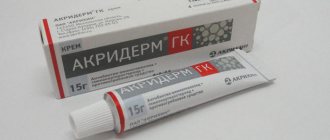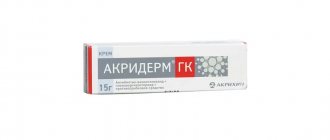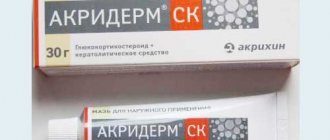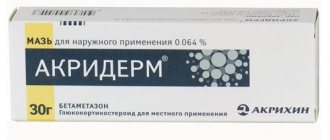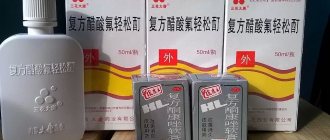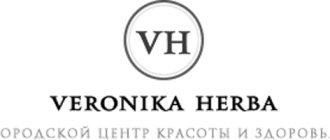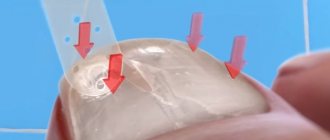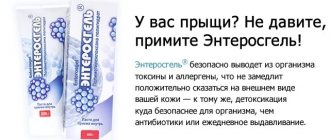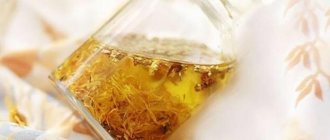Akriderm GK is a combination product used in the treatment of dermatological diseases. The effectiveness of the medicine is ensured by its multicomponent composition and its effect on one of the causes of skin problems - bacteria or fungi.
The use has contraindications and limitations, so it is important to study the instructions before starting use.
Composition and release form
Akriderm®
| Cream | 1 g |
| betamethasone dipropionate | 0.64 mg |
| excipients: nipagin; paraffin paraffin; petrolatum; propylene glycol; medical vaseline oil; emulsifying cetostearyl alcohol type A or emulsifying wax type “Lanette SX”; disodium salt of ethylenediaminetetraacetic acid (trilon B); sodium sulfite 7-water; purified water |
in tubes of 15 or 30 g; in a cardboard pack 1 tube.
Akriderm® GENTA
| Cream for external use | 1 g |
| betamethasone dipropionate | 0.64 mg |
| gentamicin sulfate | 1 mg |
| excipients: nipagin; propylene glycol; Vaseline oil; macrogol 20 cetostearyl ester; cetostearyl alcohol; disodium ethylenediaminetetraacetate; sodium phosphate disubstituted; potassium phosphate monosubstituted; purified water |
in tubes of 15 or 30 g; in a cardboard pack 1 tube.
Akriderm® GK
| Cream for external use | 1 g |
| betamethasone dipropionate | 0.64 mg |
| clotrimazole | 10 mg |
| gentamicin sulfate | 1 mg |
| excipients: petroleum jelly; propylene glycol; medical vaseline oil; cetostearyl alcohol; macrogol cetostearyl ester; trilon B; sodium dihydrogen phosphate dihydrate (sodium phosphate monosubstituted 2-water); purified water |
in tubes of 15 or 30 g; in a cardboard pack 1 tube.
Akriderm® SK
| Ointment for external use | 1 g |
| betamethasone dipropionate | 0.64 mg |
| (equivalent to 0.5 mg betamethasone) | |
| salicylic acid | 30 mg |
| excipients: petroleum jelly; Vaseline oil |
in tubes of 15 g or 30 g; in a cardboard pack 1 tube.
Advantages of Akriderm SK ointment
First of all, it is worth noting the affordable price, convenient form of release of the drug "Akriderm SK" and packaging formats. Patients can purchase both 30 g and 15 g of the product. The drug is available to a wide range of consumers not only due to its attractive price. It has over-the-counter status.
But the main advantages of Akriderm SK are its unique combined composition and medicinal properties:
- the drug penetrates deeply into the site of inflammation;
- salicylic acid reduces the risk of side effects due to the action of the glucocorticosteroid betamethasone;
Characteristic
Akriderm®
Glucocorticosteroid for local use.
Akriderm® GENTA
Combined drug for external use (glucocorticosteroid + antibiotic-aminoglycoside).
Akriderm® GK
Combined preparation for external use (glucocorticosteroid + antibiotic-aminoglycoside + antifungal agent).
Akriderm® SK
Combined preparation for external use (glucocorticosteroid + keratolytic agent).
Pharmacodynamics
The corticosteroid betamethasone dipropionate inhibits the accumulation of leukocytes, the release of lysosomal enzymes and pro-inflammatory mediators at the site of inflammation, inhibits phagocytosis, reduces vascular tissue permeability, and prevents the formation of inflammatory edema.
Gentamicin is a broad-spectrum antibiotic from the aminoglycoside group. Has a bactericidal effect against pathogens of primary and secondary bacterial skin infections. Active against gram-negative bacteria: Pseudomonas aeruginosa, Aerobacter aerogenes, Escherichia coli, Proteus vulgaris, Klebsiella pneumoniae; gram-positive bacteria: Streptococcus spp. (susceptible strains of group A beta- and alpha-hemolytic streptococcus), Staphytococcus spp. (coagulase-positive, coagulase-negative and some penicillinase-producing strains). Inactive against anaerobes, fungi and viruses.
Clotrimazole has an antifungal effect by disrupting the synthesis of ergosterol, which is an integral part of the cell membrane of fungi. Active against: Trichophyton rubrum, Trichophyton mentagrophytes, Epidermophyton floccosum, Microsporum canis, Candida albicans, Malassezia furtur (Pityrosporum orbiculare).
Salicylic acid provides a keratolytic, antimicrobial effect, eliminates horny layers and promotes deeper penetration of GCS.
Research and effectiveness
Before determining the causative agent of the disease, combination drugs with a wide spectrum of antibacterial action are prescribed. These include Akriderm GK. It may be the drug of choice, as it is active against common bacterial and fungal pathogens.
Research results show a good therapeutic effect of the ointment in the treatment of dermatoses, chronic inflammatory diseases, and fungal-bacterial infections. Using the product gives a quick anti-inflammatory effect. Due to its effectiveness and relative safety, it is recommended for dermatoses of various origins. The use of the drug provides a high level of bacterial cure.
Source
to: Kasikhina E.I., Glazko I.I. “Problems of mixed infection: solutions and features of pathogenesis,” 2014.
Indications of the drug Akriderm® SK
Akriderm®
Allergic skin diseases (including acute, subacute and chronic contact dermatitis, occupational dermatitis, seborrheic dermatitis, atopic dermatitis, solar dermatitis, neurodermatitis, pruritus, dyshidrotic dermatitis, eczema); acute and chronic forms of non-allergic dermatitis; psoriasis.
Akriderm® GENTA
Dermatitis (simple and allergic), especially secondarily infected, eczema (atopic, childhood, coin-shaped), atopic dermatitis (diffuse neurodermatitis), simple chronic lichen (limited neurodermatitis), solar dermatitis, exfoliative dermatitis, radiation dermatitis, diaper rash, psoriasis, itching.
Akriderm® GK
Treatment of dermatoses complicated by primary and/or secondary infection, pityriasis versicolor, limited and diffuse neurodermatitis, dermatomycosis (including inguinal, foot) caused by pathogens sensitive to the drug.
Akriderm® SK
Local treatment of dermatoses accompanied by hyperkeratosis: psoriasis, limited and diffuse neurodermatitis, lichen planus, eczema, dyshidrotic dermatitis, ichthyosis and ichthyosiform changes.
Analogs
Each form has its own analogue. List of structural substitutes by form (similar in composition):
| Form | Structural substitute |
| Akriderm SK | Rederm |
| Akriderm | Betamethasone-Vertex |
| Akriderm genta | Celestoderm |
| Akriderm GK | Triderm |
Non-structural substitutes contain another active ingredient. These include:
- Hydrocortisone ointment 1% - contains hydrocortisone, less effective, helps with allergic skin diseases without complications.
- Triacort - contains triamcinolone acetonide, helps with eczematous and psoriatic rashes, atopy and other skin pathologies (available strictly according to prescription!).
The choice of a substitute should be made by a doctor.
Akriderm is a popular line of external products in the field of dermatology. It is used for the treatment of skin diseases of various nature, such as complicated dermatitis (caused by allergies), eczema, neurodermatitis, and fungal damage to the skin. For each pathology, a different form of medication is selected that most effectively eliminates the symptoms of the disease. With proper use of drugs, the risk of unwanted effects is minimal.
Contraindications
Hypersensitivity to any of the components of the drug, skin tuberculosis, skin manifestations of syphilis, chicken pox, herpes simplex, skin post-vaccination reactions, open wounds, lactation and children under 1 year of age; additionally for the drug Akriderm®: trophic ulcers of the leg, rosacea, acne vulgaris; additionally for the drug Akriderm® GK: in the treatment of external otitis - perforation of the tympanic membrane; additionally for the drug Akriderm® SK: perioral dermatitis.
Treatment
If erysipelas develops on a leg, arm or other part of the body, the approach will always be comprehensive - local treatment alone is simply not enough. Moreover, the emphasis is largely on increasing immunity, otherwise the risks that the disease will recur are very high. Special medications are used to work with the immune system, but it is important for the patient to change their lifestyle: rest well, carefully monitor their health, eat right, and eliminate negative factors.
In the treatment of erysipelas, antibiotics are used, as well as antibacterial drugs from other groups. Drug therapy is selected individually - you should not prescribe medications yourself under any circumstances.
Along with taking medications, it is necessary to treat the affected skin: with special solutions, powders, aerosols. And the ointments that people love to prescribe for themselves - synthomycin, ichthyol, Vishnevsky - are strictly prohibited in this case, since they can provoke complications and cause the development of an abscess. The use of traditional medicine in any form is not allowed - in the treatment of erysipelas it is extremely dangerous!
Patients must have a preventive conversation regarding the nuances of hygiene during treatment. So, you need to change bed linen every day, take care of air access to the affected area, and regularly take a shower in warm, very comfortable water. Do not wipe the skin - only soak it with paper towels.
Physiotherapeutic methods are also used for erysipelas: ultraviolet irradiation, magnetic therapy, UHF, electrophoresis, certain types of laser therapy, applications with warm paraffin. At each stage of treatment, specific procedures are prescribed, and they are selected individually - for each patient and his condition. Any amateur activity is also inappropriate here, otherwise you can harm your health.
Very serious complications require surgical treatment.
If you encounter such a problem, we recommend immediately contacting the JSC Medicine clinic. We are located in Moscow and have a large staff of professional dermatologists, therapists and other specialists who can help you. And modern conditions for diagnosis and treatment will help achieve results much faster.
If doctors begin treatment in a timely manner and the patient follows all recommendations, the disease can be cured within 10-14 days.
Use during pregnancy and breastfeeding
The safety of topical use of GCS in pregnant women has not been established; the prescription of drugs in this group during pregnancy is justified only if the potential benefit outweighs the possible risk. During pregnancy, drugs in this group should not be used in high doses or for a long time.
It has not been established whether local use of GCS can cause them to appear in mother's milk, so the issue of stopping breastfeeding should be addressed.
At-risk groups
Most often, women over 50 years of age are affected by this disease, but it can also occur in infants. In their case, infection occurs after streptococcus enters the wound of the umbilical region. There is no explanation for this fact, but people with blood group III suffer from erysipelas more often. There is also a connection with the place of residence. In South Asia, as well as in Africa, this disease is very rare.
People with a low level of immunity, weakened by illness, stress, treatment and other factors are at risk.
Side effects
When GCS is applied topically, the following may be observed: burning, irritation, dry skin, folliculitis, hypertrichosis, acne-like rashes, hypopigmentation, perioral dermatitis, allergic contact dermatitis. With long-term use, as well as the use of occlusive dressings, skin maceration, secondary infection, skin atrophy, prickly heat, purpura.
Akriderm®
When applied to large surfaces of the body, mainly in children, systemic side effects of GCS may occur (hyperglycemia, glucosuria, reversible inhibition of adrenal function, manifestation of Cushing's syndrome).
Akriderm® GENTA
Akriderm® GK
When applied to large surfaces of the body, mainly in children, systemic side effects of GCS (hyperglycemia, glucosuria, reversible inhibition of adrenal cortex function, manifestation of Cushing's syndrome) and gentamicin (nephrotoxic and ototoxic effects) may occur.
Akriderm® SK
When applied to large surfaces of the body, mainly in children, systemic side effects of GCS and salicylates may occur.
If adverse reactions occur that are not described in the instructions, you should consult a doctor.
Undesirable manifestations
When using an external remedy, undesirable manifestations are possible, but they are mild.
Undesirable manifestations in all forms:
- local reactions: itching, burning, dry skin, folliculitis, hypertrichosis, steroid acne, allergic skin manifestations;
- when applying bandages: stretch marks, prickly heat, attachment of secondary flora, weeping;
- systemic manifestations: increased blood pressure, leaching of calcium from bones, weight gain, edema, ulcerative defects of the digestive tract mucosa, exacerbation of focal infections, menstrual irregularities, poor sleep, agitation.
The list is supplemented by the following undesirable manifestations of individual forms:
| Akriderm | Akriderm genta |
|
|
Directions for use and doses
Akriderm®
Akriderm® GENTA
Akriderm® GK
Externally. Apply a thin layer to the affected area of the skin 2 times a day - morning and evening. Another frequency of use can be determined by the doctor, based on the severity of the disease. In mild cases, it is enough to apply the cream, as a rule, once a day; For more severe lesions, more frequent use may be necessary.
The duration of treatment depends on the effectiveness and tolerability of therapy and is 2–4 weeks.
If clinical improvement does not occur, it is necessary to clarify the diagnosis.
Akriderm® SK
Externally. Apply a thin layer to the affected area of the skin 2 times a day - morning and evening. Another frequency of use can be determined by the doctor, based on the severity of the disease. In mild cases, it is enough to apply the ointment, as a rule, once a day; For more severe lesions, more frequent use may be necessary.
How to use Akriderm GK
The Akriderm GK instructions only provide for external use of ointment or cream.
The medicine is used twice a day, gently rubbed into affected areas of the skin. As prescribed by the doctor and depending on the severity of the pathology, an increase or decrease in the number of applications is allowed.
The course of treatment can reach 2-4 weeks, but positive changes are observed already in the first days of application.
It is not recommended to use the product with sealed bandages without a doctor’s recommendation in order to avoid accelerated absorption of the antibiotic and glucocorticosteroid, which increases the likelihood of side effects.
If no improvement is observed with regular use, it is necessary to clarify the diagnosis and reconsider the treatment regimen.
special instructions
If signs of hypersensitivity or skin irritation associated with the use of drugs are observed, treatment should be discontinued and adequate therapy should be selected for the patient.
With prolonged treatment, when applying drugs to large surfaces of the skin, when using occlusive dressings, and also in children, systemic absorption of GCS is possible.
For children over 1 year of age, medications are prescribed only according to strict indications and under medical supervision, because Systemic side effects associated with betamethasone may develop. When using the drug on large surfaces and/or under an occlusive dressing, suppression of the function of the hypothalamic-pituitary-adrenal system and the development of symptoms of hypercortisolism may occur; a decrease in the excretion of growth hormone and an increase in intracranial pressure may be observed.
On the skin of the face more often than on other surfaces of the body, after long-term treatment with topical corticosteroids, atrophic changes may appear; the course of treatment in this case should not exceed 5 days.
The cream and ointment are not intended for use in ophthalmology. Avoid getting the drug into your eyes.
With long-term use of the drug, its withdrawal should be carried out gradually.
Akriderm cream for external use 0.05% 15g
Compound
Active substance: betamethasone - 50 mg. Excipients: methyl parahydroxybenzoate - 0.2 g, solid paraffin - 9 g, petroleum jelly - 3 g, propylene glycol - 5 g, liquid paraffin - 18 g, emulsion wax - 7 g, disodium edetate - 0.1 g, sodium sulfite - 0.05 g, purified water - up to 100 g.
Pharmacokinetics
When the drug is applied cutaneously in therapeutic doses, transdermal absorption of the active substance into the blood is very insignificant. The use of occlusive dressings, inflammation and skin diseases increase the transdermal absorption of betamethasone, which may lead to an increased risk of systemic side effects.
Indications for use
Skin diseases amenable to glucocorticosteroid therapy:
- atopic dermatitis;
- allergic contact dermatitis;
- eczema (various forms);
- contact dermatitis (including occupational) and other non-allergic dermatitis (including solar and radiation dermatitis);
- reactions to insect bites;
- psoriasis;
- bullous dermatoses;
- discoid lupus erythematosus;
- lichen planus;
- exudative multimorphic erythema;
- skin itching of various etiologies.
Contraindications
- Hypersensitivity to betamethasone or other components of the drug;
- lupus;
- skin manifestations of syphilis;
- bacterial, fungal, viral (chickenpox, herpes simplex) skin diseases;
- skin post-vaccination reactions;
- open wounds;
- trophic ulcers of the leg;
- rosacea, acne vulgaris;
- skin cancer, nevus, atheroma, melanoma, hemangioma, xanthoma, sarcoma;
- lactation period;
- children's age up to 1 year.
Directions for use and doses
Externally. Akriderm® cream is applied in a thin layer to the affected area of the skin 2 times a day - morning and evening, lightly rubbing. On areas with thicker skin (for example, elbows, palms and feet), as well as places from which the drug is easily washed off, Akriderm® cream can be applied more often.
The duration of treatment depends on the effectiveness and tolerability of therapy and is usually no more than 4 weeks. Therapy may be repeated several times throughout the year.
Akriderm® cream is used for treatment in the acute inflammatory phase of the disease, including weeping skin lesions.
In children and patients with facial skin lesions, the course of treatment should not exceed 5 days.
If clinical improvement does not occur, it is necessary to clarify the diagnosis.
Storage conditions
The drug should be stored out of the reach of children at a temperature of 15 to 25°C.
Best before date
4 years. Do not use after the expiration date.
special instructions
If there is no effect of treatment within two weeks, it is recommended to consult your doctor for a possible clarification of the diagnosis. If irritation or hypersensitivity reaction is observed when using the drug, treatment should be stopped and consult your doctor. For secondary fungal or bacterial infections, appropriate medications must be used. If there is no immediate positive effect, the use of Akriderm should be discontinued until all signs of infection are eliminated.
Long-term use of the drug on the skin of the face is not recommended. Akriderm should not be used in the eye area, because... in this case, the development of cataracts, glaucoma, fungal infection and exacerbation of herpetic infection is possible.
Use in pediatrics
Children may be more susceptible to the use of topical corticosteroids that cause hypothalamic-pituitary-adrenal (HPA) axis suppression than older patients due to increased drug absorption associated with their larger surface area to body weight ratio. The following side effects were observed in children taking local corticosteroids: suppression of the HPA system function, Cushing's syndrome, linear growth retardation, delayed weight gain, increased intracranial pressure. Symptoms of adrenal suppression in children include decreased plasma cortisol levels and lack of response to ACTH stimulation. Increased intracranial pressure is manifested by bulging of the fontanel, headache, and bilateral papilledema.
Description
Glucocorticosteroid for local use.
Pharmacodynamics
Akriderm® is a glucocorticosteroid for external use. It has anti-inflammatory, antiallergic, antiexudative, vasoconstrictive, antipruritic and antiproliferative effects. Inhibits the accumulation of leukocytes, the release of lysosomal enzymes and pro-inflammatory mediators at the site of inflammation, inhibits phagocytosis, reduces vascular tissue permeability, and prevents the formation of inflammatory edema
When applied to the surface of the skin, the drug has a quick and strong effect at the site of inflammation, reducing the severity of objective symptoms (erythema, swelling, lichenification) and subjective sensations (itching, irritation, pain).
Side effects
As a rule, it is mild in nature.
With external use of glucocorticosteroids, the following may be observed: skin itching, burning, irritation, dry skin, folliculitis, hypertrichosis, stretch marks, acne-like rashes (“steroid” acne), hypopigmentation, perioral dermatitis, allergic contact dermatitis.
With long-term use, as well as the use of occlusive dressings, skin maceration, secondary infection, skin atrophy, local hirsutism, telangiectasia, prickly heat, purpura.
When applied to large surfaces of the body, mainly in children, systemic side effects of glucocorticosteroids may occur (hyperglycemia, glucosuria, reversible inhibition of adrenal function, manifestation of Itsenko-Cushing syndrome).
If adverse reactions occur that are not described in the instructions, you should consult a doctor.
Use during pregnancy and breastfeeding
Due to the fact that the safety of the use of local corticosteroids in pregnant women has not been established, the use of drugs of this class during pregnancy is justified only if the benefit to the mother clearly outweighs the possible harm to the fetus. Drugs in this group should not be used by pregnant women in large doses for a long time.
Since it has not yet been established whether glucocorticosteroids, when applied topically and systemically absorbed, can pass into breast milk, a decision should be made to stop breastfeeding or discontinue the drug, taking into account how necessary its use is for the mother.
Interaction
No interaction of the drug with other drugs has been identified.
Overdose
Symptoms: excessive or prolonged use of local corticosteroids can cause inhibition of the function of the pituitary-adrenal system, which can cause the development of secondary adrenal insufficiency and the appearance of symptoms of hypercortisolism, including Cushing's syndrome.
Treatment: Appropriate symptomatic treatment is indicated. Acute symptoms of hypercortisolism are usually reversible. If necessary, correction of electrolyte imbalance is indicated. In case of chronic toxic effects, gradual withdrawal of GCS is recommended.
Impact on the ability to drive vehicles and operate machinery
Does not affect.

